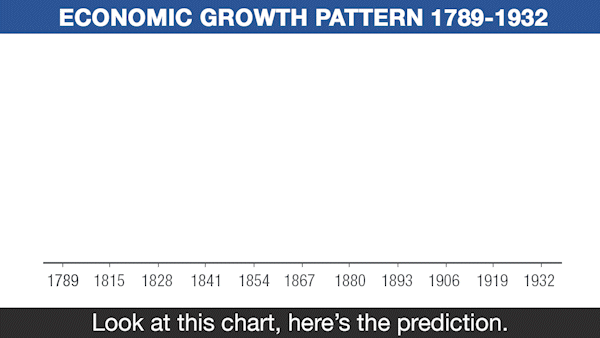|
This is urgent. Be sure to watch this video, read the transcript below … or … at the very minimum, take protective action as soon as you can. Wednesday is the last day. — Martin |
Jessica Borg: Hello and welcome!
Today, the experts at Weiss Ratings are releasing major new forecasts.
 |
This is a very significant event in the investment world, and the reason is clear.
Their previous forecasts have proven to be amazingly accurate. They warned of a 1987 stock market crash months in advance, as well as the explosive recovery that followed right afterward.
In 2006 and 2007, they warned that the real estate boom was about to end and that it would trigger three things: A massive debt crisis, a stock market crash and a Great Recession.
Then in March of 2009, they announced that the worst was over that stocks were about to catch fire again, and they did.
They forecast the election of Donald Trump and the great bull market in stocks that followed.
They are well known for publicly calling every major up-and-down move in the gold market since 1999. And just last June, they forecast the war in Ukraine, along with the massive surge in resource and commodity prices we're seeing now.
Today, two of the Weiss experts are here with us: Founder, Dr. Martin D. Weiss, and senior analyst, Sean Brodrick. Gentlemen, so nice to see you. Thank you so much for being here today.
Martin Weiss: I'm glad to be here. And the timing of this meeting could not be more urgent.
Jess: Because of the war in Ukraine?
Martin: Not only that because so much has happened so quickly since the last time we met and because so much more is about to happen now.
Jess: We last met in June of 2021. Among the forecasts you made at that time, two really stick out in my mind: You forecast a rising cycle of war, specifically pinpointing Ukraine.
Martin: In fact, Sean said it would turbocharge one of the greatest commodity supercycles in history.
Jess: We know what's happened in Ukraine since then. Sean, tell us more about what's happened in resources and resource stocks?
 |
Sean Brodrick: Oil has doubled in price. Wheat has doubled in price. All in the matter of just a few months! And they weren't the biggest winners.
For example, nickel, one of the “energy metals” that I always talk about. It has absolutely gone to the roof, up a 148%. Meanwhile, since we made that forecast in early June of 2021, some of my favorite resource stocks have skyrocketed in tandem.
Gold Fields — up 72%.
Marathon Oil — up 91.6%.
Teck Resources — up 103.4%.
Alcoa — up a stunning 184%.
Jess: That is stunning. I know you've also been shouting from the rooftops about the surge in inflation overall.
Sean: And now the government's measure of consumer price inflation has catapulted higher from 1.7%, one year ago, to 7.9% for the year ending last month.
Martin: Do you realize that this means it has more than quadrupled in just 12 months? That's the fastest jump in the year-over-year inflation rate in U.S. history.
Sean: That does not yet reflect the price explosions we've seen in oil, nickel, wheat and other commodities since the Russian invasion of Ukraine.
Our Most Important Forecast in 50 Years
Jess: I want to take a second to first congratulate you on your previous forecasts. But now, your forecasts for the world's economy truly have a new, terrifying dimension to them.
Martin: It's probably our most important forecast ever in the 50 years since I founded this company, and it is frightening. On the flip side, though, there are going to be tremendous profit opportunities for those in the know.
Jess: I want to get to those new forecasts in just a moment. First though, what gives you confidence that these things are actually going to happen?
Sean: The economic cycles that have driven world events since before the time of the pharaohs — the same cycles in the investment markets that triggered the great crash of 1929 and every boom and bust since. Now, once again, these cycles are coming to a head.
Martin: I'm personally well aware of just how powerful these cycles are from my studies as well. They're everywhere in the universe. They're everywhere in nature.
Jess: Our heartbeat, the Earth rotating on its axis, the Earth revolving around the Sun.
Martin: Yes. And human economic behavior is also very cyclical. In my younger days, I was a cultural anthropologist and I specialized in what's called economic anthropology.
In my fieldwork, I personally witnessed the cycles in small agricultural communities all over the world. I did fieldwork on primitive cultures and peasant societies, and I saw how their entire livelihood tied to the seasons.
What's even more interesting is that, in modern society, we see similar cycles in markets, in mass psychology, in political trends.
The difference is that we not only see them, but we can also measure those cycles through market prices, company financials, in polls and in the national census.
And those side cycles are Sean's great passion. Sean is the first person in our organization who wrote extensively about the great supercycle.
Sean: Here's the interesting thing: When you track a cycle carefully, you can also predict what it's going to do next. This is especially true of certain commodities like metals, which are very cyclical. And it's true for a whole range of economic cycles.
Jess: Who first discovered these economic cycles?
Sean: Among the first was a Russian economist, Nikolai Kondratiev. He told the Soviet authorities that, eventually, their society, their communist society, would actually fall apart.
As you might expect, that news wasn't well received and things didn't go well for him. He was sent to prison and he was eventually executed. That's probably the harshest review an economist ever got for his work.
Jess: Right. Agreed. In the end, though, he was right.

Sean: He was. Then in the 1930s, President Hoover got blamed for the Great Depression. So, after Truman left office, Hoover tried to figure out what went wrong. He saw himself as very knowledgeable in economics and as someone who was called upon when they wanted to fix things, but then the economy, I mean, it just blew up under his watch, right?
So, he turned to another economist, a man named Edward Dewey, and Hoover gave Dewey the task of finding out what caused the Great Depression. Dewey studied the history of depressions, and it became obvious to him that the Great Depression, it actually could have been predicted.
Jess: How is that possible?
Sean: First, Dewey discovered cycles in the price of copper. As I told you, metal prices are very cyclical. Then he looked at nickel, and then he looked at the wheat market, the same markets that are surging so dramatically today.
Eventually, Dewey uncovered economic cycles in terms of the gross domestic product, or GDP. And it was the GDP cycle that actually predicted the Great Depression years ahead of time.
Look at this chart. The red line is the prediction. The black line shows what actually happened as the Great Depression got underway. It follows the prediction with uncanny accuracy.
Jess: It is uncanny. Is that the main cycle you use at Weiss Ratings?
Sean: Well, it's one of them, yeah. But we combine it with other cycles like the business inventory cycle, eight- and 12-year stock market cycles, the 12-year cycle in the currency markets and, of course, the cycles in the gold market.
Martin: I want to add one thing that we've been stressing since 2015 and investors must absolutely not ignore for one more year or even one more day.
It's another cycle that's putting tremendous pressure on the global economy and has now burst onto the scene as one of the most powerful cycles of all.
Jess: And that is what?
Martin: The cycle of war.
Jess: The cycle of war?
Martin: You seem surprised.
Jess: I'm not surprised that we're talking about war. Russian tanks are rolling across Ukraine, Russian bombs are falling on cities there. And on the other side of the world, Chinese fighter jets are probing the airspace of Taiwan.
What surprises me is the concept that war is cyclical, that it can be predicted in some way. Is that possible?
Martin: Very much so.
I studied the cycle of war going back to the birth of civilization in Sumer and Babylonia between the Euphrates and the Tigris rivers, which is now modern-day Iraq.
Our studies of the cycle of war are based on these thousands of years of recorded history. And these cycles actually predicted there would be a bottom.
In other words, a peaceful time in the late 1980s or early 1990s or thereabouts. And sure enough, that bottom in the war cycle came on Christmas day, 1991. The day that the Soviet flag came down over the Kremlin in Moscow for the last time. The day that the prior Cold War ended.
But sadly, the war cycle is now ramping up toward the other side of that same cycle. The same Iron Curtain that was raised in Moscow so dramatically in 1991 has suddenly descended on Russia again.
Vladimir Putin is not only reducing Ukraine to rubble, he is turning Russia into a prison.
Sean: Meanwhile, BP (BP), Shell (SHLX), ExxonMobil (XOM), Netflix (NFLX) and Starbucks (SBUX) are all abandoning multi-billion-dollar investments in Russia. McDonald's, a famous symbol of the Soviet Union’s opening to the West has now shut down its 850 restaurants in Russia.
Martin: Five years ago, we forecast exactly this scenario. We called it the New Cold War and we prayed that it would not come true. Unfortunately, it has come true. Now, let's just hope that our new prayers for peace are heard and it does not get a lot worse.
Jess: What do you predict will actually happen?
Martin: Let me start with our prediction of what will NOT happen: Nuclear war.
It's the ultimate deterrent against war, and the chances it will happen are barely worth mentioning.
Jess: But the fact is nearly everyone is talking about it. Many maybe in soft whispers, but some quite loudly.
Martin: That's a good thing. The more people are afraid and the more they talk about it, the more confident we are that it will not happen. It's when people ignore the danger, when they're complacent, that's when we worry. Even then, though, it would be a remote possibility.
Jess: You say the war cycle is ramping up. So, what's your prediction?
Sean: We predict a global war.
Jess: World War III?
Martin: We prefer the term “global war.” By that, we mean global trade wars, global cyber wars, global currency wars.
We predict it will be waged between the United States and its allies against Russia, China and their allies. There will also be shooting wars, but we predict those will be limited to one region or one country.
Jess: Like we saw in Southeast Asia during the Cold War?
Martin: And like we're seeing now in Ukraine.
Jess: When you and Sean first made this forecast five years ago, it seemed so extreme, so hard to believe. Now it's very rational, very much in line with what some of the smartest global strategists are saying.
Sean: But for most investors, it's still very frightening — a global disruption of enormous dimensions.
Jess: Be more specific if you would, Sean.
Sean: A massive disruption in the post-World War II global order, a complete realignment that pits East versus West. Ominous new dangers! And for those who know what to do, unheard-of investment opportunities.
|
Click Here to learn more about these Unheard of Investment Opportunities Now |
Jess: Sean, I trust you'll share what those are?
Sean: Of course.
Jess: And you'll give us your specific forecasts of war?
Martin: No. Neither Sean nor I will do that. We are not here to forecast wars. We're here to forecast the economic consequences of war.
The Economic
Consequences of War
Sean: First, countries, large and small will double and triple their defense spending.
And they'll finance that spending by piling up some of the biggest new debts since World War II.
To absorb the debts, they'll print more money than they printed during the Great Recession or the great pandemic combined.
And they will create the greatest global inflation since the 1970s.
Jess: We're already seeing inflation because of supply chain disruptions.
Martin: And we'll probably see much more of the same. But ultimately, supply chain disruptions are not the primary driver of truly massive, sustained inflation.
What's driving the massive and sustained inflation is the big government spending, the big pile-up of debt and the crazy money printing that's behind it.
Sean: This is all terrible, yes. But I must stress, the good thing is that there are going to be tremendous profit opportunities for investors.
We predict, for example, that the price of crude oil will rise to $250 per barrel.
We predict the price of gold will go to $7,000 per ounce.
We predict companies leveraged to these commodities will surge even more.
So, if you understand history, you have the opportunity to protect your wealth and grow your wealth while the majority may end losing theirs.
Martin: But most people have never experienced this. They have never seen the cycle of inflation.
Sean: That's very true.
Martin: And very few understand the cycle of war. So, they don't realize that nearly all the cycles we study are about to converge.
Jess: Like the perfect storm.
Sean: You could call it that. We call it a great convergence, a great convergence of cycles.
Jess: Can you tell us something about each of those cycles?
Sean: The first is the Kondratieff Wave. It has been pointing lower into the first half of the 2020s. This cycle reflects the demise of governments that built up these monumental unpayable debts.
Government debts to prop up their teetering economies.
Government debts to finance various forms of socialism.
Government debts to buffer the pain the population feels.
Government debts to ward off social unrest or even civil war.
And, as we said, government debts to finance war machines.
Remember: The man who originally discovered this cycle was sent to prison and executed by Stalin.
Now you could say that his ghost is returning to haunt all of those who failed to learn the lesson — the lesson that socialism was a failure.
The big picture is this: As these cycles reach a peak, we will see the end of an era when governments could rack up debt with impunity and the beginning of a new era where those same governments must pay the price of their folly.
Martin: A financial day of reckoning.
Sean: Yes, but it won't happen in just one day. It'll take place in phases over a period of years.
Four Phases of Armageddon
Phase one is ending right now. This is the period in which governments around the world were able to continue borrowing and printing money with impunity …
To continue reading, go to this page.
To watch the full video, click here.
To begin protecting your assets by building wealth rapidly, jump here. Wednesday is your last day.



